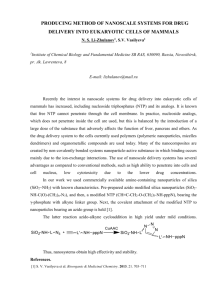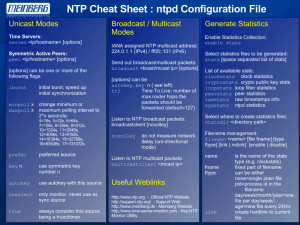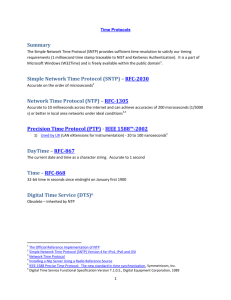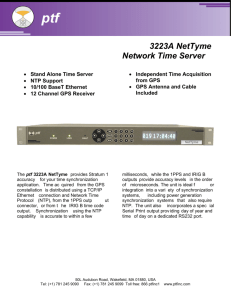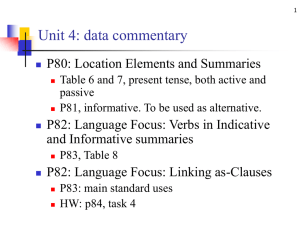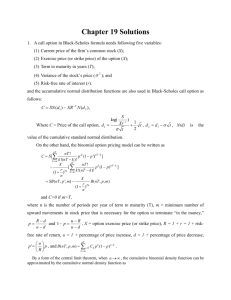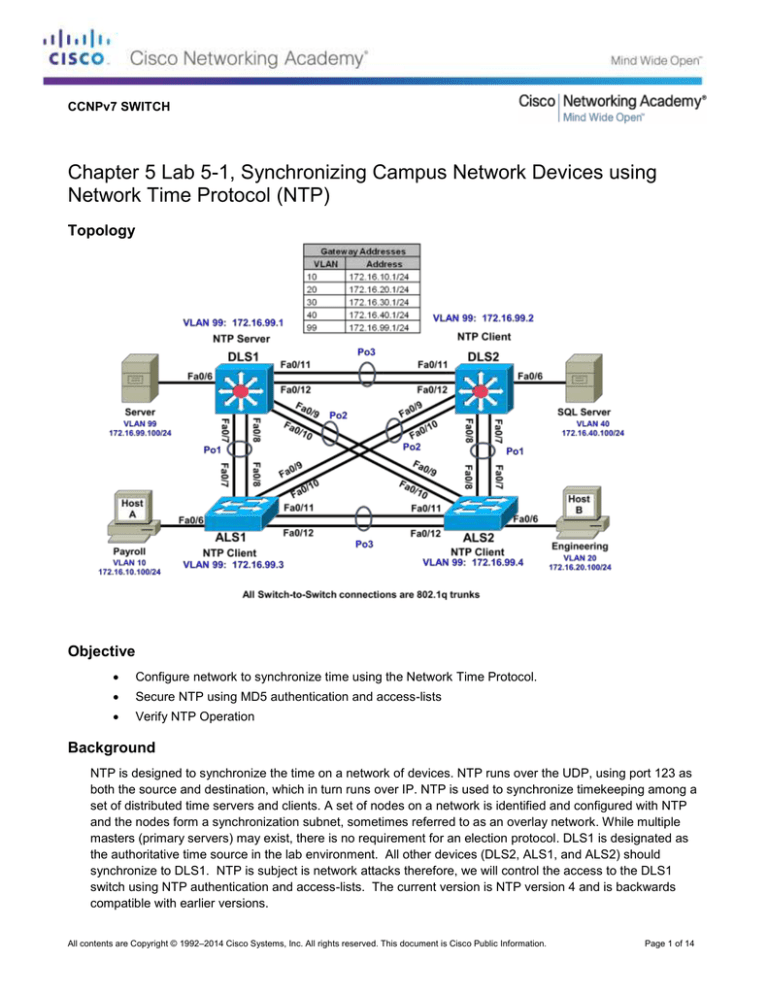
CCNPv7 SWITCH
Chapter 5 Lab 5-1, Synchronizing Campus Network Devices using
Network Time Protocol (NTP)
Topology
Objective
Configure network to synchronize time using the Network Time Protocol.
Secure NTP using MD5 authentication and access-lists
Verify NTP Operation
Background
NTP is designed to synchronize the time on a network of devices. NTP runs over the UDP, using port 123 as
both the source and destination, which in turn runs over IP. NTP is used to synchronize timekeeping among a
set of distributed time servers and clients. A set of nodes on a network is identified and configured with NTP
and the nodes form a synchronization subnet, sometimes referred to as an overlay network. While multiple
masters (primary servers) may exist, there is no requirement for an election protocol. DLS1 is designated as
the authoritative time source in the lab environment. All other devices (DLS2, ALS1, and ALS2) should
synchronize to DLS1. NTP is subject is network attacks therefore, we will control the access to the DLS1
switch using NTP authentication and access-lists. The current version is NTP version 4 and is backwards
compatible with earlier versions.
All contents are Copyright © 1992–2014 Cisco Systems, Inc. All rights reserved. This document is Cisco Public Information.
Page 1 of 14
CCNPv7 Chapter 5 Lab 5-1, Configuring NTP
Note: This lab uses the Cisco WS-C2960-24TT-L switch with the Cisco IOS image c2960-lanbasek9-mz.1502.SE6.bin and the Catalyst 3560V2-24PS switch with the Cisco IOS image c3560-ipservicesk9-mz.1502.SE6.bin. Other switches and Cisco IOS Software versions can be used if they have comparable capabilities
and features. Depending on the switch model and Cisco IOS Software version, the commands available and
output produced might vary from what is shown in this lab.
Required Resources
2 switches (Cisco 2960 with the Cisco IOS Release 15.0(2)SE6 C2960-LANBASEK9-M image or
comparable)
2 switches (Cisco 3560 with the Cisco IOS Release 15.0(2)SE6 C3560-IPSERVICESK9-M image or
comparable)
Ethernet and console cables
4 PC’s connected to the topology according to the diagram.
Part 1: Prepare for the Lab
Step 1: Prepare the switches for the lab
Use the reset.tcl script you created in Lab 1 “Preparing the Switch” to set your switches up for this lab.
Then load the file BASE.CFG into the running-config with the command copy flash:BASE.CFG
running-config. An example from DLS1:
DLS1# tclsh reset.tcl
Erasing the nvram filesystem will remove all configuration files! Continue?
[confirm]
[OK]
Erase of nvram: complete
Reloading the switch in 1 minute, type reload cancel to halt
Proceed with reload? [confirm]
*Mar 7
*Mar 7
Reason:
<switch
18:41:40.403: %SYS-7-NV_BLOCK_INIT: Initialized the geometry of nvram
18:41:41.141: %SYS-5-RELOAD: Reload requested by console. Reload
Reload command.
reloads - output omitted>
Would you like to enter the initial configuration dialog? [yes/no]: n
Switch> en
*Mar 1 00:01:30.915: %LINK-5-CHANGED: Interface Vlan1, changed state to
administratively down
Switch# copy BASE.CFG running-config
Destination filename [running-config]?
184 bytes copied in 0.310 secs (594 bytes/sec)
DLS1#
All contents are Copyright © 1992–2014 Cisco Systems, Inc. All rights reserved. This document is Cisco Public Information.
Page 2 of 14
CCNPv7 Chapter 5 Lab 5-1, Configuring NTP
Step 2: Configure basic switch parameters.
Configure an IP address on the management VLAN according to the diagram. VLAN 1 is the default
management VLAN, but following best practice, we will use a different VLAN. In this case, VLAN 99.
Enter basic configuration commands on each switch according to the diagram.
DLS1 example:
DLS1# configure terminal
Enter configuration commands, one per line. End with CNTL/Z.
DLS1(config)# interface vlan 99
DLS1(config-if)# ip address 172.16.99.1 255.255.255.0
DLS1(config-if)# no shutdown
The interface VLAN 99 will not come up immediately, because the Layer 2 instance of the VLAN does not yet
exist. This issue will be remedied in subsequent steps
(Optional) On each switch, create an enable secret password and configure the VTY lines to allow remote
access from other network devices.
DLS1 example:
DLS1(config)# enable secret class
DLS1(config)# line vty 0 15
DLS1(config-line)# password cisco
DLS1(config-line)# login
Note: The passwords configured here are required for NETLAB compatibility only and are NOT
recommended for use in a live environment.
Note(2): For purely lab environment purposes, it is possible to configure the VTY lines so that they accept
any Telnet connection immediately, without asking for a password, and place the user into the privileged
EXEC mode directly. The configuration would be similar to the following example for DLS1:
DLS1(config)# enable secret class
DLS1(config)# line vty 0 15
DLS1(config-line)# no login
DLS1(config-line)# privilege level 15
a. Configure default gateways on the access layer switches ALS1 and ALS2. The distribution layer switches
will not use a default gateway because they act as Layer 3 devices. The access layer switches act as
Layer 2 devices and need a default gateway to send management VLAN traffic off of the local subnet for
the management VLAN.
ALS1(config)# ip default-gateway 172.16.99.1
ALS2(config)# ip default-gateway 172.16.99.2
Step 4: Configure trunks and EtherChannels between switches.
EtherChannel is used for the trunks because it allows you to utilize both Fast Ethernet interfaces that are
available between each device, thereby doubling the bandwidth.
Note: It is good practice to shut down the interfaces on both sides of the link before a port channel is created
and then reenable them after the port channel is configured.
All contents are Copyright © 1992–2014 Cisco Systems, Inc. All rights reserved. This document is Cisco Public Information.
Page 3 of 14
CCNPv7 Chapter 5 Lab 5-1, Configuring NTP
a. Configure trunks and EtherChannels from DLS1 and DLS2 to the other three switches according to the
diagram. The switchport trunk encapsulation {isl | dot1q} command is used because these switches
also support ISL encapsulation. The native vlan has been changed to vlan 666 and the switchport has
been set to nonegotiate. A sample configuration has been provided to assist you with the trunking and
etherchannel configurations.
DLS1(config)# interface range fastEthernet 0/7 - 8
DLS1(config-if-range)# switchport trunk encapsulation dot1q
DLS1(config-if-range)# switchport mode trunk
DLS1(config-if-range)# switchport trunk native vlan 666
DLS1(config-if-range)# switchport nonegotiate
DLS1(config-if-range)# channel-group 1 mode desirable
DLS1(config-if-range)# no shut
Creating a port-channel interface Port-channel 1
b. Configure the trunks and EtherChannel from ALS1 and ALS2 to the other switches. Notice that no
encapsulation type is needed because the 2960 supports only 802.1q trunks. The native vlan has been
changed to vlan 666 and the switchport has been set to nonegotiate. A sample configuration has been
provided to assist you with the trunking and etherchannel configurations.
ALS1(config)# interface range fastEthernet 0/7 - 8
ALS1(config-if-range)# switchport mode trunk
ALS1(config-if-range)# switchport trunk native vlan 666
ALS1(config-if-range)# switchport nonegotiate
ALS1(config-if-range)# channel-group 1 mode desirable
ALS1(config-if-range)# no shut
c.
Verify trunking between DLS1, ALS1, and ALS2 using the show interface trunk command on all
switches.
DLS1# show interface trunk
Port
Po1
Po2
Po3
Mode
on
on
on
Encapsulation
802.1q
802.1q
802.1q
Status
trunking
trunking
trunking
Native vlan
1
1
1
Port
Po1
Po2
Po3
Vlans allowed on trunk
1-4094
1-4094
1-4094
Port
Po1
Po2
Po3
Vlans allowed and active in management domain
1
1
1
Port
Po1
Po2
Po3
Vlans in spanning tree forwarding state and not pruned
1
1
1
d. Issue the show etherchannel summary command on each switch to verify the EtherChannels. In the
following sample output from ALS1, notice the three EtherChannels on the access and distribution layer
switches.
ALS1# show etherchannel summary
Flags: D - down
P - bundled in port-channel
All contents are Copyright © 1992–2014 Cisco Systems, Inc. All rights reserved. This document is Cisco Public Information.
Page 4 of 14
CCNPv7 Chapter 5 Lab 5-1, Configuring NTP
I
H
R
U
-
stand-alone
Hot-standby
Layer3
in use
s - suspended
(LACP only)
S - Layer2
f - failed to allocate aggregator
M
u
w
d
-
not in use, minimum links not met
unsuitable for bundling
waiting to be aggregated
default port
Number of channel-groups in use: 3
Number of aggregators:
3
Group Port-channel Protocol
Ports
------+-------------+-----------+---------------------------------------------1
Po1(SU)
PAgP
Fa0/7(P)
Fa0/8(P)
2
Po2(SU)
PAgP
Fa0/9(P)
Fa0/10(P)
3
Po3(SU)
PAgP
Fa0/11(P)
Fa0/12(P)
Which EtherChannel negotiation protocol is in use here?
____________________________________________________________________________________
Step 5: Configure VTP on DLS2, ALS1 and ALS2.
a. Change the VTP mode of ALS1 and ALS2 to client and VTP modes of DLS2 to server.
ALS1(config)# vtp mode client
Setting device to VTP CLIENT mode for VLANS.
ALS2(config)# vtp mode client
Setting device to VTP CLIENT mode for VLANS.
Set DLS2 to server mode.
DLS2(config)#vtp mode server
Setting device to VTP Server mode for VLANS
NOTE: Switches default to vtp mode server. However, remember the base
configuration modifies this setting to vtp mode transparent.
b. Verify the VTP changes with the show vtp status command.
ALS1# show vtp status
VTP Version capable
: 1 to 3
VTP version running
: 1
VTP Domain Name
:
VTP Pruning Mode
: Disabled
VTP Traps Generation
: Disabled
Device ID
: 0017.95d1.8b80
Configuration last modified by 0.0.0.0 at 0-0-00 00:00:00
Feature VLAN:
-------------VTP Operating Mode
Maximum VLANs supported locally
Number of existing VLANs
Configuration Revision
MD5 digest
:
:
:
:
:
Client
255
5
0
0x57 0xCD 0x40 0x65 0x63 0x59 0x47 0xBD
All contents are Copyright © 1992–2014 Cisco Systems, Inc. All rights reserved. This document is Cisco Public Information.
Page 5 of 14
CCNPv7 Chapter 5 Lab 5-1, Configuring NTP
0x56 0x9D 0x4A 0x3E 0xA5 0x69 0x35 0xBC
Step 6: Configure VTP on DLS1.
a. Create the VTP domain on VTP server DLS1 and create VLANs 10, 20, 30, 40 and 99 for the domain.
NOTE: Switches default to vtp mode server. However, remember the base configuration modifies this
setting to vtp mode transparent.
DLS1(config)# vtp
DLS1(config)# vtp
DLS1(config)# vtp
Setting device to
DLS1(config)# vlan
DLS1(config-vlan)#
DLS1(config-vlan)#
DLS1(config-vlan)#
DLS1(config-vlan)#
DLS1(config-vlan)#
DLS1(config-vlan)#
DLS1(config-vlan)#
DLS1(config-vlan)#
DLS1(config-vlan)#
DLS1(config-vlan)#
DLS1(config-vlan)#
domain NTP
version 2
mode server
VTP Server mode for VLANS
10
name
vlan
name
vlan
name
vlan
name
vlan
name
vlan
name
Finance
20
Engineering
30
Server-Farm1
40
Server-Farm2
99
Management
666
NATIVE_DO_NOT_USE
Step 7: Configure access ports.
a. Configure the host ports of all four switches. The following commands configure the switch port mode as
access, place the port in the proper VLANs, and turn on spanning-tree PortFast for the ports.
DLS1(config)# interface fastEthernet 0/6
DLS1(config-if)# switchport mode access
DLS1(config-if)# switchport access vlan 99
DLS1(config-if)# spanning-tree portfast
DLS1(config-if)# no shutdown
DLS2(config)# interface fastEthernet 0/6
DLS2(config-if)# switchport mode access
DLS2(config-if)# switchport access vlan 40
DLS2(config-if)# spanning-tree portfast
DLS2(config-if)# no shutdown
ALS1(config)# interface fastEthernet 0/6
ALS1(config-if)# switchport mode access
ALS1(config-if)# switchport access vlan 10
ALS1(config-if)# spanning-tree portfast
DALS1(config-if)# no shutdown
ALS2(config)# interface fastEthernet 0/6
ALS2(config-if)# switchport mode access
ALS2(config-if)# switchport access vlan 20
ALS2(config-if)# spanning-tree portfast
ALS2(config-if)# no shutdown
b. Ping from the host on VLAN 10 to the host on VLAN 40. The ping should fail.
Are these results expected at this point? Why?
All contents are Copyright © 1992–2014 Cisco Systems, Inc. All rights reserved. This document is Cisco Public Information.
Page 6 of 14
CCNPv7 Chapter 5 Lab 5-1, Configuring NTP
_______________________________________________________________________________
_______________________________________________________________________________
_______________________________________________________________________________
Note: The switchport host command can be used to configure individual access ports. This command
automatically activates access mode, PortFast, and removes all associations of the physical switch port
with the port-channel interfaces (if there are any).
Step 8: Configure SVIs for L3 interfaces and enable routing.
DLS1(config)# ip routing
DLS1(config)# interface loopback 1
DLS1(config-if)# ip address 200.200.200.1 255.255.255.0
DLS1(config-if)# exit
Note: The purpose of this loopback interface is to be used as the source for NTP.
DLS1(config)# interface vlan 10
DLS1(config-if)# ip address 172.16.10.1 255.255.255.0
DLS1(config-if)# exit
DLS1(config)# interface vlan 20
DLS1(config-if)# ip address 172.16.20.1 255.255.255.0
DLS1(config)# interface vlan 30
DLS1(config-if)# ip address 172.16.30.1 255.255.255.0
DLS1(config)# interface vlan 40
DLS1(config-if)# ip address 172.16.40.1 255.255.255.0
DLS2(config)# ip routing
DLS2(config)# interface vlan 10
DLS2(config-if)# ip address 172.16.10.2 255.255.255.0
DLS2(config-if)# exit
DLS2(config)# interface vlan 20
DLS2(config-if)# ip address 172.16.20.2 255.255.255.0
DLS2(config-if)# exit
DLS2(config)# interface vlan 30
DLS2(config-if)# ip address 172.16.30.2 255.255.255.0
DLS2(config)# interface vlan 40
DLS2(config-if)# ip address 172.16.40.2 255.255.255.0
DLS2(config)# ip route 200.200.200.0 255.255.255.0 172.16.99.1
NOTE: This static route is used to route to R1’s loopback interface. R1’s loopback interface will be used
as the NTP source for synchronization purposes in subsequent steps in the lab.
Step 9: Configure the system clock .
a. The system clock can be set using a variety of methods. The system clock can be manually set, the time
can be derived from an NTP source or from a subset of NTP (SNTP). It is important that all of your
All contents are Copyright © 1992–2014 Cisco Systems, Inc. All rights reserved. This document is Cisco Public Information.
Page 7 of 14
CCNPv7 Chapter 5 Lab 5-1, Configuring NTP
devices have accurate timestamps for use in systems reporting and for tracking validity of X.509
certificates used in Public Key Infrastructure and for event correlation in attack identification.
DLS1# show clock
*02:27:16.911 UTC Mon Mar 1 1993
b. The show clock command displays what time is currently set on the device.
On DLS1, manually reconfigure the system clock using the clock set command from privileged exec
mode of operation.
DLS1# clock set ?
hh:mm:ss Current Time
DLS1# clock set 1:06:15 ?
<1-31> Day of the month
MONTH
Month of the year
DLS1# clock set 1:06:15 8 September ?
<1993-2035> Year
DLS1# clock set 1:06:15 8 September 2014
*Sep 8 01:06:15.000: %SYS-6-CLOCKUPDATE: System clock has been updated from
02:32:45 UTC Mon Mar 1 1993 to 01:06:15 UTC Mon Sep 8 2014, configured from
console by console.
c.
Verify that the system clock has been updated.
DLS1# show clock
01:06:32.070 UTC Mon Sep 8 2014DLS1#sh clock
*02:27:16.911 UTC Mon Mar 1 1993
d. The default timezone is UTC. Change the default timezone to EDT -5. The -5 is the difference in hours
from UTC. Use clock timezone zone hours-offset command in global configuration.
DLS1(config)# clock timezone ?
WORD name of time zone
DLS1(config)# clock timezone EDT ?
<-23 - 23> Hours offset from UTC
DLS1(config)# clock timezone EDT -5 ?
<0-59> Minutes offset from UTC
<cr>
DLS1(config)# clock timezone EDT -5
Sep 8 01:13:45.191: %SYS-6-CLOCKUPDATE: System clock has been updated from
01:13:45 UTC Mon Sep 8 2014 to 20:13:45 EDT Sun Sep 7 2014, configured from
console by console.
e. Enable daylight savings time. The command clock summer-time EDT recurring command will
allow the automatic switch to daylight saving time.
DLS1(config)# clock summer-time ?
All contents are Copyright © 1992–2014 Cisco Systems, Inc. All rights reserved. This document is Cisco Public Information.
Page 8 of 14
CCNPv7 Chapter 5 Lab 5-1, Configuring NTP
WORD
name of time zone in summer
DLS1(config)# clock summer-time EDT ?
date
Configure absolute summer time
recurring Configure recurring summer time
DLS1(config)# clock summer-time EDT recurring
Sep 8 01:14:10.516: %SYS-6-CLOCKUPDATE: System clock has been updated from
20:14:10 EDT Sun Sep 7 2014 to 21:14:10 EDT Sun Sep 7 2014, configured from
console by console.]
NOTE:
This command used without parameters defaults to United States rules.
Verify clock settings using the show clock command with the keyword detail.
DLS1# show clock detail
21:14:31.395 EDT Sun Sep 7 2014
Time source is user configuration
Summer time starts 02:00:00 EDT Sun Mar 9 2014
Summer time ends 02:00:00 EDT Sun Nov 2 2014
The clock setting should reflect the local time.
Setting the clocks manually is not viewed as an accurate method of keeping track of time and events in
networks. It is also not a scalable solution to manually configure time on all network devices. The Network
Time Protocol (NTP) allows the network device to poll an authoritative time source for synchronization.
Step 10: Configure NTP.
NTP is used to make sure all network devices in the campus are synchronized. Time accuracy can be derived
from three different external sources: Atomic clock, GPS receiver, and accurate time source. NTP
synchronizes using UDP port 123. All of the devices must be configured with NTP.
a. Configure DLS1 as the authoritative time source in the campus network by using the ntp master
command.
DLS1(config)# ntp master ?
<1-15>
Stratum number
<cr>
This command should only be used if you do not have a reliable external reference clock. We will use
ntp master stratum_number command in global configuration mode. The stratum number should be
configured with a high number in the event that there is more reliable NTP source available. A machine
running NTP automatically chooses the machine with the lowest stratum number that is configured to
communicate with using NTP as its time source. The lower the stratum number the more trustworthy the
accuracy of the time source.
DLS1(config)# ntp master 10
It is recommended that more than one device be designated as NTP server. If multiple devices are
configured as ntp servers, the ntp server 200.200.200.1 prefer command can be used to
designate one as preferred over another. In this lab scenario, only one device will be used as an NTP
time source.
All contents are Copyright © 1992–2014 Cisco Systems, Inc. All rights reserved. This document is Cisco Public Information.
Page 9 of 14
CCNPv7 Chapter 5 Lab 5-1, Configuring NTP
b. Configure DLS2, ALS1, and ALS2 to synchronize to DLS1 using the ntp server A.B.C.D ( IP address
of peer ) command. NTP synchronization should always refer to the most stable interface. Loopback
interfaces are considered always up interfaces and therefore, the best choice for NTP synchronization.
Also, the local time zone should be configured on each local device. Also, configure these devices with
the same time zone and summer time configuration as on DLS1.
DLS2(config)# ntp server ?
A.B.C.D
IP address of peer
WORD
Hostname of peer
X:X:X:X::X IPv6 address of peer
ip
Use IP for DNS resolution
ipv6
Use IPv6 for DNS resolution
vrf
VPN Routing/Forwarding Information
DLS2(config)# ntp server 200.200.200.1
DLS2(config)# clock timezone EDT -5
Mar 1 00:48:25.968: %SYS-6-CLOCKUPDATE: System clock has been updated from
00:48:25 UTC Mon Mar 1 1993 to 20:48:25 EDT Sun Feb 28 1993, configured from
console by console.
DLS2(config)# clock summer-time ?
WORD
name of time zone in summer
DLS2(config)# clock summer-time EDT recurring
Mar 1 00:54:36.589: %SYS-6-CLOCKUPDATE: System clock has been updated from
20:54:36 EDT Sun Feb 28 1993 to 20:54:36 EDT Sun Feb 28 1993, configured from
console by console.
NOTE: Ensure that these commands are repeated on ALS1 and ALS2.
Step 11: Verify NTP
.
On DLS2, ALS1, and ALS2, use the show ntp status command to verify if these device clocks have
synchronized to DLS1.
DLS2# show ntp status
Clock is synchronized, stratum 11, reference is 200.200.200.1
nominal freq is 119.2092 Hz, actual freq is 119.2101 Hz, precision is 2**17
reference time is AF3CE6C4.CD93512C (14:47:16.803 EDT Mon Mar 1 1993)
clock offset is -4.5084 msec, root delay is 2.03 msec
root dispersion is 7944.53 msec, peer dispersion is 2.14 msec
loopfilter state is 'CTRL' (Normal Controlled Loop), drift is -0.000007161 s/s
system poll interval is 64, last update was 2 sec ago.Outputs for ALS1 and ALS2
should be similar to the output displayed above for DLS2.
The stratum will be +1 from the stratum value used on the master in the network. In this lab scenario, we use
ntp master 10. This indicates a stratum of 10 + 1 = 11. The stratum 11 is indicated in the show output.
NOTE: NTP may take up to 5 minutes to synchronize.
Step 12: Secure NTP Operation using Access-Lists and Authentication
Time Servers can provide synchronization services in all directions to other devices in your network. A rogue NTP
server to come in and falsify time on your network. Also, a rogue device could send a large number of bogus
synchronization requests to your server preventing it from servicing legitimate devices. Configure an access-list
so that polling can only come from members of the 172.16.0.0/16 network. NTP masters must allow “peer”
All contents are Copyright © 1992–2014 Cisco Systems, Inc. All rights reserved. This document is Cisco Public Information.
Page 10 of 14
CCNPv7 Chapter 5 Lab 5-1, Configuring NTP
access to source with IP address 127.127.x.1. This IP address is the internal server address created by the NTP
master command. The local router synchronizes using this IP. Use the show ntp associations command to
view the IP address of the internal NTP server.
NTP operation can also be secured using MD5 authentication. Authentication is enabled with the ntp
authenticate command. The authentication keys are defined with ntp authentication-key command.
The number specifies a unique NTP key. Valid keys are identified using the ntp-trusted-key command. It is
important to note that NTP does not authenticate clients. NTP authenticates the source. Devices can still
respond to unathenticated requests. For this reason, access lists should be used in conjunction with NTP
authenciation to restrict NTP access.
a. Configure NTP authentication on NTP server.
DLS1(config)# ntp authenticate
DLS1(config)# ntp authentication-key 1 md5 P@55word
DLS1(config)# ntp trusted-key 1
b. Configure NTP authentication on NTP clients (DLS2, ALS1, ALS2).
DLS2(config)# ntp authentication-key 1 md5 P@55word
DLS2(config)# ntp authenticate
DLS2(config)# ntp trusted-key 1
Use the show ntp status command to verify that clock is still synchronized. If the clock shows
unsynchronized, the client has not successfully authenticated.
DLS2# show ntp status
Clock is synchronized, stratum 11, reference is 200.200.200.1
nominal freq is 119.2092 Hz, actual freq is 119.2106 Hz, precision is 2**17
reference time is D7C2D495.6AD26EF6 (12:24:05.417 EDT Tue Sep 16 2014)
clock offset is -0.0479 msec, root delay is 1.63 msec
root dispersion is 5.83 msec, peer dispersion is 2.48 msec
loopfilter state is 'CTRL' (Normal Controlled Loop), drift is -0.000011269
s/s
system poll interval is 128, last update was 35 sec ago.
a. Repeat this commands on ALS1 and ALS2. Verify that the device clocks are synchronized using the
appropriate show command.
C. Control NTP Access using Access-Lists
View the output for the show ntp associations. If your device is configured as NTP master, then you
must allow access to source IP of 127.127.x.1. This is because 127.127.x.1 is the internal server that is
created by the ntp master command. The value of the third octet varies between platforms.
DLS1# sh ntp associations
address
ref clock
st
when
poll reach delay offset
disp
*~127.127.1.1
.LOCL.
9
0
16
377 0.000
0.000
0.241
* sys.peer, # selected, + candidate, - outlyer, x falseticker, ~ configured
Use the following commands to ensure that only devices on the 172.16.0.0 /16 network are able to poll or
send requests to the NTP server. The ntp access-group peer command allows the devices to
All contents are Copyright © 1992–2014 Cisco Systems, Inc. All rights reserved. This document is Cisco Public Information.
Page 11 of 14
CCNPv7 Chapter 5 Lab 5-1, Configuring NTP
synchronize itself to remote systems that pass the access-list. Time synchronization and control queries are
allowed.
DLS1(config)# access-list 1 permit 127.127.1.1
DLS1(config)# access-list 2 permit 172.16.0.0 0.0.255.255
DLS1(config)# ntp access-group peer ?
<1-99>
Standard IP access list
<1300-1999> Standard IP access list (expanded range)
WORD
Named access list
DLS1(config)# ntp access-group peer 1
DLS1(config)# ntp access-group ?
peer
query-only Allow only control queries
serve
Provide server and query access
serve-only Provide only server access
Provide full access
DLS1(config)# ntp access-group serve-only 2
This command references the source address listed in access-list 2 to determine if NTP services will
rendered to the requesting device.
Step 13: Verify NTP on all devices.
Use the show ntp associations, show ntp status, show clock detail commands to verify
synchronization and configurations across the campus network.
DLS1# show ntp status
Clock is synchronized, stratum 10, reference is 127.127.1.1
nominal freq is 119.2092 Hz, actual freq is 119.2092 Hz, precision is 2**17
reference time is D7BD8B98.3BCA053A (11:11:20.233 EDT Fri Sep 12 2014)
clock offset is 0.0000 msec, root delay is 0.00 msec
root dispersion is 7937.58 msec, peer dispersion is 7937.50 msec
loopfilter state is 'CTRL' (Normal Controlled Loop), drift is 0.000000000 s/s
system poll interval is 16, last update was 5 sec ago.
DLS1# show ntp associations
address
ref clock
st
when
poll reach delay offset
disp
*~127.127.1.1
.LOCL.
9
12
16
1 0.000
0.000 7937.5
* sys.peer, # selected, + candidate, - outlyer, x falseticker, ~ configured
DLS1# show clock detail
11:11:38.268 EDT Fri Sep 12 2014
Time source is NTP
Summer time starts 02:00:00 EDT Sun Mar 9 2014
Summer time ends 02:00:00 EDT Sun Nov 2 201
Compare the output on DLS2 to ALS1 and ALS2 devices.
DLS2# show ntp status
Clock is synchronized, stratum 11, reference is 200.200.200.1
nominal freq is 119.2092 Hz, actual freq is 119.2096 Hz, precision is 2**17
reference time is D7BDB443.388A60FB (15:04:51.220 EDT Fri Sep 12 2014)
clock offset is -10.7549 msec, root delay is 1.42 msec
root dispersion is 16.67 msec, peer dispersion is 3.42 msec
All contents are Copyright © 1992–2014 Cisco Systems, Inc. All rights reserved. This document is Cisco Public Information.
Page 12 of 14
CCNPv7 Chapter 5 Lab 5-1, Configuring NTP
loopfilter state is 'CTRL' (Normal Controlled Loop), drift is -0.000002674
s/s
system poll interval is 64, last update was 204 sec ago.
DLS2# show ntp associations
address
ref clock
st
when
poll reach delay offset
disp
*~200.200.200.1
127.127.1.1
10
18
64
377 1.414 -10.754
3.427
* sys.peer, # selected, + candidate, - outlyer, x falseticker, ~ configured
DLS2# show clock detail
15:08:32.977 EDT Fri Sep 12 2014
Time source is NTP
Summer time starts 02:00:00 EDT Sun Mar 9 2014
Summer time ends 02:00:00 EDT Sun Nov 2 2014
ALS1# show ntp status
Clock is synchronized, stratum 11, reference is 200.200.200.1
nominal freq is 119.2092 Hz, actual freq is 119.2097 Hz, precision is 2**17
reference time is D7BDB481.693FE416 (18:05:53.411 UTC Fri Sep 12 2014)
clock offset is -12.9590 msec, root delay is 1.59 msec
root dispersion is 20.49 msec, peer dispersion is 4.45 msec
loopfilter state is 'CTRL' (Normal Controlled Loop), drift is -0.000004084
s/s
system poll interval is 64, last update was 369 sec ago.
ALS1# show ntp associations
address
ref clock
st
when
poll reach delay offset
disp
*~200.200.200.1
127.127.1.1
10
49
64
377 1.590 -12.959
4.455
* sys.peer, # selected, + candidate, - outlyer, x falseticker, ~ configured
ALS1# show clock detail
18:12:11.276 UTC Fri Sep 12 2014
Time s
ALS2# show ntp status
Clock is synchronized, stratum 11, reference is 200.200.200.1
nominal freq is 119.2092 Hz, actual freq is 119.2098 Hz, precision is 2**17
reference time is D7BDB418.17E9DD27 (18:04:08.093 UTC Fri Sep 12 2014)
clock offset is -16.3063 msec, root delay is 1.50 msec
root dispersion is 24.85 msec, peer dispersion is 4.54 msec
loopfilter state is 'CTRL' (Normal Controlled Loop), drift is -0.000004397
s/s
system poll interval is 64, last update was 428 sec ago.
ALS2# show clock detail
18:11:22.236 UTC Fri Sep 12 2014
Time source is NTP
Step 14. Review the requirements in the next lab before proceeding with erasing of
your device configurations and removal of the VLAN database.
All contents are Copyright © 1992–2014 Cisco Systems, Inc. All rights reserved. This document is Cisco Public Information.
Page 13 of 14
CCNPv7 Chapter 5 Lab 5-1, Configuring NTP
All contents are Copyright © 1992–2014 Cisco Systems, Inc. All rights reserved. This document is Cisco Public Information.
Page 14 of 14

